BigFoot Networks Killer NIC: Killer Marketing or Killer Product?
by Gary Key on October 31, 2006 2:00 AM EST- Posted in
- Networking
Gaming Performance
As usual, gaming performance was tested with a variety of current games. We ran benchmarks at our standard 1280x1024 resolution. Given the number of users that run 19 inch LCDs these days, 1280x1024 represents one of the most commonly used resolutions at this time.
Battlefield 2
This benchmark is probably the most intense one we ran as it occurred on the Daqing Oilfield map with 64 players battling it out in a chaotic frenzy. This was also the most difficult map we had to experience from a viewpoint of keeping our players together and trying to accomplish the same tasks. If you saw two players constantly missing the vehicle rides and spending a lot of time in the trees sniping then it was us. We ran Battlefield 2 using the highest quality graphics settings available in the video settings. The game itself is best experienced with average in-game frame rates of 40 and up.
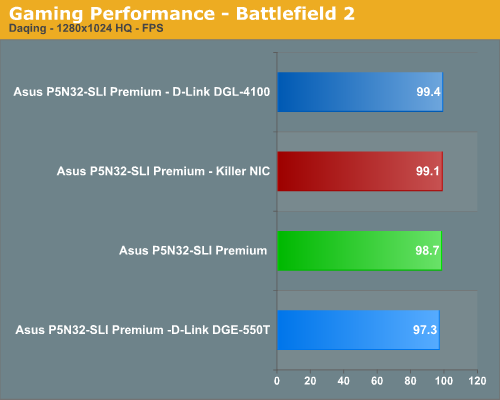

In our first game we actually find our D-Link combination performing slightly better than the other solutions from a benchmark viewpoint. During actual game play we noticed the frame rates and general smoothness of the system was best on the NVIDIA nForce 590SLI and followed closely by the Killer NIC. Several times during our testing with the D-Link DGL-4100 we would see several pauses while vehicles passed or several characters were in close proximity of each other. This behavior was worse on the D-Link DGE-550T when GameFuel was disabled on the router. In our first game we do not see $279.99 worth of game play improvement and the Killer NIC certainly did not allow us to dominate.
F.E.A.R.
We played both the Asylum and Deadwood 16-player maps. We decided to report the Asylum results as this is our favorite map currently. The Deadwood map generated similar results so we are not hiding any information. F.E.A.R. is a very graphics intensive game and we switch all graphic settings to maximum (except for soft shadows, which are disabled). An average frame rate for F.E.A.R. can dip into the teens at times which is not good for a first person shooter. We still found the game playable around 35fps or above in multiplayer.
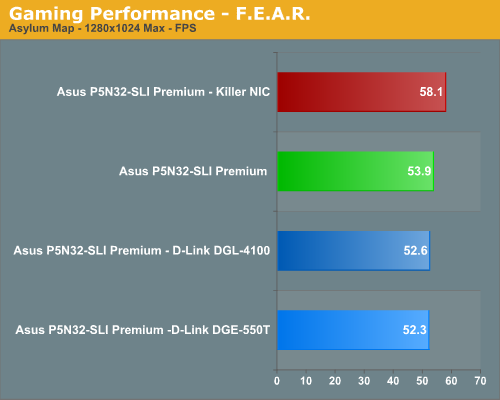

This is the money title for the Killer NIC. BigFoot Networks ships a copy of F.E.A.R. with every card so it should be expected to offer better frame rates and ping rates. We see a 7% increase in frame rates over the NVIDIA nForce 590SLI NIC and a 10% increase over the D-Link combination. In actual game play we found the Killer NIC to offer the most fluid experience and our ability to quickly transverse the map actually felt smoother than the other two solutions. The ping rates were actually higher than the D-Link router and nForce 590SLI but we did not find ping rate making a huge difference in this game. The question is did the Killer NIC improve our game play or skills? It really did not but it could for those who are significantly better players at this game than we are currently. In this case we will chalk a point up for the Killer NIC for improving frame rates.
Quake 4
This game should be a significant test for the Killer NIC as it requires extremely good hand to eye coordination along with lightning fast reflexes. This is just the game that would truly benefit from both improved ping and frame rates. We played on the Campgrounds Redux map with a total of 16 players. This is our favorite map from Quake III Arena and we were glad to see it return. We set our video settings to high and then fired up the game.
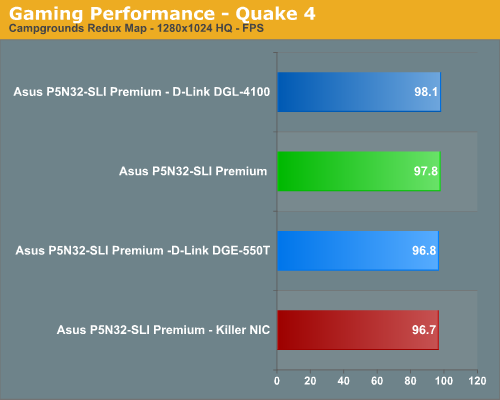
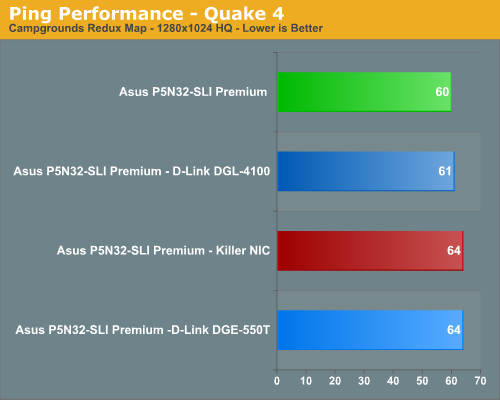
Actually, Quake 4 limits true frame rate to 60 fps during game play whether or not VSync is enabled. However, various timedemos and FRAPS will report the frame rate your system is capable of providing without the cap. In this case, we believe due to the speed of the game that ping rate is an extremely important performance measurement. This is one game where the Killer NIC loses on both fronts and it is mainly attributable to the excellent network code already provided in the game engine that does not benefit from offloading technology. The current performance leads us to believe we can expect to see the same results in the eagerly awaited Enemy Territory: Quake Wars.
Counter Strike Source
This is another game that BigFoot Networks touts as a premier title that will show improvements in both frame and ping rates. We are playing on the Office map with 32 players and we varied our online session times to ensure we were playing on a full server. Our settings were once again set to high quality at a 1280x1024 resolution. We find the game is very playable at 50 fps or better.
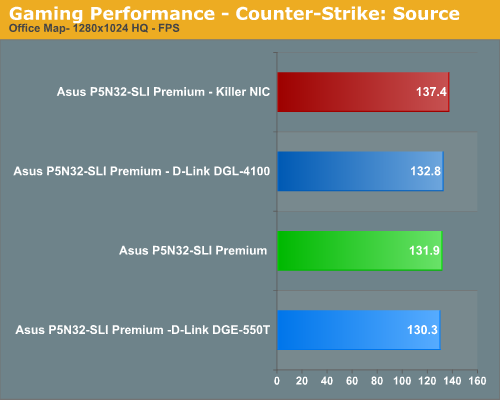

We did see frame rate improvements between three to five percent in this game. However, at these frame rates we really do not think a difference of 5% is going to matter much. Like Quake 4, an excellent ping rate in this game will make a difference and in this case we just did not see a large enough variation to make a difference in our experience. The Killer NIC did provide a positive experience to some degree in CSS as game play seemed to be a little smoother after firing your weapon than our other solutions. It was not a fire, frame hitch, and then move event we experienced a few other times during testing, especially with the D-Link PCI NIC. The Killer NIC gets a point for improving frame rates as advertised. We have to take it away for failing to improve our ping rates in a game where UltimatePing (reducing ping rates on the host system) could make a difference in actual game play.
Call of Duty 2
This is another popular shooter where frame rate and ping rate are very important especially in close quarters fighting. We played on the Caen map with a 24 player limit. The amount of packet processing this game generates is significantly higher at times than Counter Strike: Source so we expected our Killer NIC to shine in this area. Our video resolution is set to 1280x1024 with all options but AA enabled. We find the game is generally playable with a 40 fps or higher rate in multiplayer.
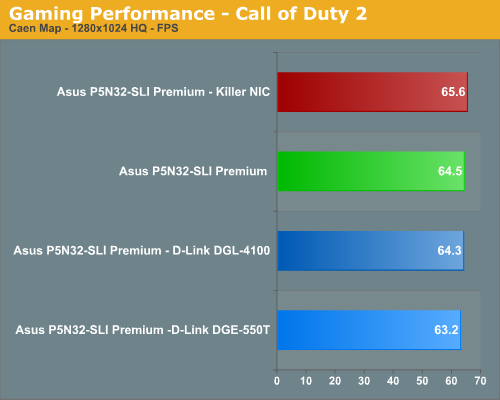
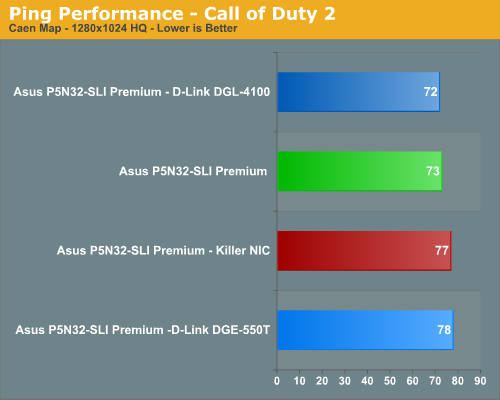
These results surprised us as we see minor frame rate improvements but ping rates were up to 7% greater than our D-Link router or NVIDIA NIC. The frame rate improvement is only worth mentioning because this game is generally GPU bound so any benchmark differences between systems is noticeable. Were the frame rate differences during game play noticeable? No they were not but we can tell you the increased ping rates were noticeable. This was the first game we encountered where the actual game play was not smooth with the Killer NIC. We noticed choppy break points at certain sections, especially when going building to building in the center of the map. We tried this map at different times during the day and noticed this issue several times. It seemed to be worse when throwing a grenade as we blew our selves up twice during testing. We might be slow and have weak arms in real life but our game characters did not need this handicap.
As usual, gaming performance was tested with a variety of current games. We ran benchmarks at our standard 1280x1024 resolution. Given the number of users that run 19 inch LCDs these days, 1280x1024 represents one of the most commonly used resolutions at this time.
Battlefield 2
This benchmark is probably the most intense one we ran as it occurred on the Daqing Oilfield map with 64 players battling it out in a chaotic frenzy. This was also the most difficult map we had to experience from a viewpoint of keeping our players together and trying to accomplish the same tasks. If you saw two players constantly missing the vehicle rides and spending a lot of time in the trees sniping then it was us. We ran Battlefield 2 using the highest quality graphics settings available in the video settings. The game itself is best experienced with average in-game frame rates of 40 and up.


In our first game we actually find our D-Link combination performing slightly better than the other solutions from a benchmark viewpoint. During actual game play we noticed the frame rates and general smoothness of the system was best on the NVIDIA nForce 590SLI and followed closely by the Killer NIC. Several times during our testing with the D-Link DGL-4100 we would see several pauses while vehicles passed or several characters were in close proximity of each other. This behavior was worse on the D-Link DGE-550T when GameFuel was disabled on the router. In our first game we do not see $279.99 worth of game play improvement and the Killer NIC certainly did not allow us to dominate.
F.E.A.R.
We played both the Asylum and Deadwood 16-player maps. We decided to report the Asylum results as this is our favorite map currently. The Deadwood map generated similar results so we are not hiding any information. F.E.A.R. is a very graphics intensive game and we switch all graphic settings to maximum (except for soft shadows, which are disabled). An average frame rate for F.E.A.R. can dip into the teens at times which is not good for a first person shooter. We still found the game playable around 35fps or above in multiplayer.


This is the money title for the Killer NIC. BigFoot Networks ships a copy of F.E.A.R. with every card so it should be expected to offer better frame rates and ping rates. We see a 7% increase in frame rates over the NVIDIA nForce 590SLI NIC and a 10% increase over the D-Link combination. In actual game play we found the Killer NIC to offer the most fluid experience and our ability to quickly transverse the map actually felt smoother than the other two solutions. The ping rates were actually higher than the D-Link router and nForce 590SLI but we did not find ping rate making a huge difference in this game. The question is did the Killer NIC improve our game play or skills? It really did not but it could for those who are significantly better players at this game than we are currently. In this case we will chalk a point up for the Killer NIC for improving frame rates.
Quake 4
This game should be a significant test for the Killer NIC as it requires extremely good hand to eye coordination along with lightning fast reflexes. This is just the game that would truly benefit from both improved ping and frame rates. We played on the Campgrounds Redux map with a total of 16 players. This is our favorite map from Quake III Arena and we were glad to see it return. We set our video settings to high and then fired up the game.


Actually, Quake 4 limits true frame rate to 60 fps during game play whether or not VSync is enabled. However, various timedemos and FRAPS will report the frame rate your system is capable of providing without the cap. In this case, we believe due to the speed of the game that ping rate is an extremely important performance measurement. This is one game where the Killer NIC loses on both fronts and it is mainly attributable to the excellent network code already provided in the game engine that does not benefit from offloading technology. The current performance leads us to believe we can expect to see the same results in the eagerly awaited Enemy Territory: Quake Wars.
Counter Strike Source
This is another game that BigFoot Networks touts as a premier title that will show improvements in both frame and ping rates. We are playing on the Office map with 32 players and we varied our online session times to ensure we were playing on a full server. Our settings were once again set to high quality at a 1280x1024 resolution. We find the game is very playable at 50 fps or better.


We did see frame rate improvements between three to five percent in this game. However, at these frame rates we really do not think a difference of 5% is going to matter much. Like Quake 4, an excellent ping rate in this game will make a difference and in this case we just did not see a large enough variation to make a difference in our experience. The Killer NIC did provide a positive experience to some degree in CSS as game play seemed to be a little smoother after firing your weapon than our other solutions. It was not a fire, frame hitch, and then move event we experienced a few other times during testing, especially with the D-Link PCI NIC. The Killer NIC gets a point for improving frame rates as advertised. We have to take it away for failing to improve our ping rates in a game where UltimatePing (reducing ping rates on the host system) could make a difference in actual game play.
Call of Duty 2
This is another popular shooter where frame rate and ping rate are very important especially in close quarters fighting. We played on the Caen map with a 24 player limit. The amount of packet processing this game generates is significantly higher at times than Counter Strike: Source so we expected our Killer NIC to shine in this area. Our video resolution is set to 1280x1024 with all options but AA enabled. We find the game is generally playable with a 40 fps or higher rate in multiplayer.


These results surprised us as we see minor frame rate improvements but ping rates were up to 7% greater than our D-Link router or NVIDIA NIC. The frame rate improvement is only worth mentioning because this game is generally GPU bound so any benchmark differences between systems is noticeable. Were the frame rate differences during game play noticeable? No they were not but we can tell you the increased ping rates were noticeable. This was the first game we encountered where the actual game play was not smooth with the Killer NIC. We noticed choppy break points at certain sections, especially when going building to building in the center of the map. We tried this map at different times during the day and noticed this issue several times. It seemed to be worse when throwing a grenade as we blew our selves up twice during testing. We might be slow and have weak arms in real life but our game characters did not need this handicap.










87 Comments
View All Comments
rqle - Tuesday, October 31, 2006 - link
I never like to bash a company product because always believed there a niche market, but at its very best, this product doesnt seem to justified the $300 price cost. I do believe many would buy it at a lower price.My current broadband is 3.0mbps/512kb, i can pay $5 more a month more for Verizon Fiop 15mbps/2mbp, i would rather go that route for my improve network + other capibilities. As for the side processing function, a cheap $200 (Athlon64 3200+ computer system) can do a whole lot more. Am not saying it a bad product, it just price way to high for me.
cornfedone - Tuesday, October 31, 2006 - link
SOS, DD.Just as we've seen with Asian mobos in the last few years, this NIC card is an over-hyped, under-performing POS. Just as mobos from Asus, DFI, Sapphire, Abit, and more have suffered from vcore, BIOS, memory, PCI slot and many other issues, the BigJoke NIC card is more defective goods with zero customer support. I'm sure everyone looks forward to a wiped hard drive image... due to a poorly designed NIC card.
Sooner or later consumers are gonna wise up and stop buying these defective products. Until they vote with their wallet instead of their penis, unscrupulous companies will continue to ship half baked POS products and fail to provide proper customer support. If consumers stop buying these defective goods, then the company will either correct their problems or go tits up.
autoboy - Tuesday, October 31, 2006 - link
I didn't buy a NIC to make up for my small penis, I bought a Porsche. Chicks don't notice my NIC.The K does look pretty cool. Maybe it will fit on my Porsche.
Frumious1 - Tuesday, October 31, 2006 - link
I dare say few if any people have purchased AGEIA or Killer NIC cards. As for your whining about ASUS, DFI, etc. I guess you're one of the people running a budget $50 mobo that can't understand what it's like to really push a system? Or are you the other extreme: you overclocked by 50% or more and are pissed that the system wasn't fully stable?slashbinslashbash - Tuesday, October 31, 2006 - link
You talk a lot about how it's virtually impossible to test something whose entire performance is based almost entirely on an Internet connection which is inherently variable. That's why you need some more control over the variables in your test. Namely, a LAN.For example... have 4 computers, each with exactly the same configs except for the network cards. One of them has the KillerNIC, the rest have different NICs. They are all running Unreal Tournament. You also have one computer set up as the server, on the same Gigabit Ethernet switch as the 4 "player" machines. The level is a small plain square room with no doors, trenches, or any other features. Each of the "players" is running the same script where they have unlimited ammo and a machine gun, running circles around and around, shooting constantly from the minute they respawn. Let the scripts run for 100 hours and capture the framerate and pings on each machine.
So you have 4 computer players running around in circles in a small square room, shooting each other for 100 hours. Yes, there will still be randomness, but over the course of 100 hours it should cancel out, and this test should be replicable. Any real differences between the NICs would come out over time. Run it again to make sure.
Or maybe that's not the best way of doing it. I don't even play UT2003 so I don't know what's really possible and what's not, but I've heard of people doing scripts and stuff. Maybe there are better ways of doing it, but you can eliminate the variable of the Internet connection by limiting your testing to a LAN.
Gary Key - Wednesday, November 1, 2006 - link
We tested over a LAN, the results were not that different, in fact the NVIDIA NIC and Intel PRO/1000 PT cards had better throughput and latencies the majority of the time. We did not show these results as the card is marketed to improve your Online Gaming experience. If the card had been marketed as a must have product to improve your gaming capability on a LAN then it would have been reviewed as such.
When we tested on the LAN the steps you outlined were basically followed from a script viewpoint in order to ensure the variables were kept to a minimum. We did not provide these results, maybe we should have in hindsight. Our final opinion of the card would not have changed.
Thanks for the comments. :)
Frumious1 - Tuesday, October 31, 2006 - link
The product is targeted at gamers. Look at the marketing material. now, while a LAN party goer might get some advantage out of it, there are FAR more people playing games from home using broadband connections. If this only improves performance in a LAN environment (clearly NOT what is being advertised), then it's already a failure. I like what Gary did here: look at real world testing and let us know how it turned out. Who gives a rip about controlled environments and theoretical performance increases if the reality is that the product basically doesn't help much? What's really funny is that they even show a ping "advantage" in FEAR of maximum 0.40ms and average 0.13ms. WTF!? Like anyone can notice a .13ms improvement in ping times! The frame rate improvements might be good (if they were available in many games)... still not $270+ good, though.Bladen - Tuesday, October 31, 2006 - link
Or as you touched on, do the test for a long time, or many many repeats, and let the averages soeak for themselves.shoRunner - Tuesday, October 31, 2006 - link
You pay almost $300 for the ultimate NIC card, and its PCI so it can't even get anywhere near gigbit throughput. AND the CPU utilization isn't even better than an onboard solution. PLEASE. If anyone is truely thinking about buying this, send me a PM I've got some beautiful ocean front property in Montanta to sell you for pennies on the dollar.mlau - Tuesday, October 31, 2006 - link
You underestimate this card greatly. This is the ultimate network card for linux:it could theoretically offload almost all of linux' network stack (including linux'
advanced filtering/routing capabilites and protocols). It's a firewall-router on a
card. IMHO the card is targeted for the wrong crowd (although I understand it somewhat,
since gamers are usually stupid enough to buy 2 video cards and other completely
unnecessary stuff [ageia comes to mind])